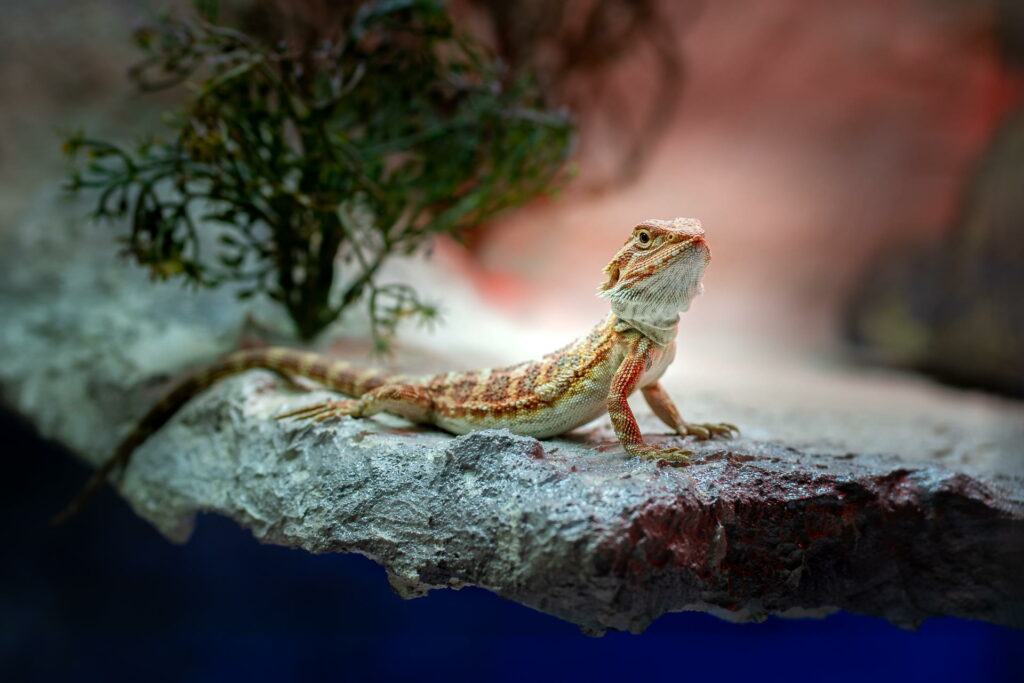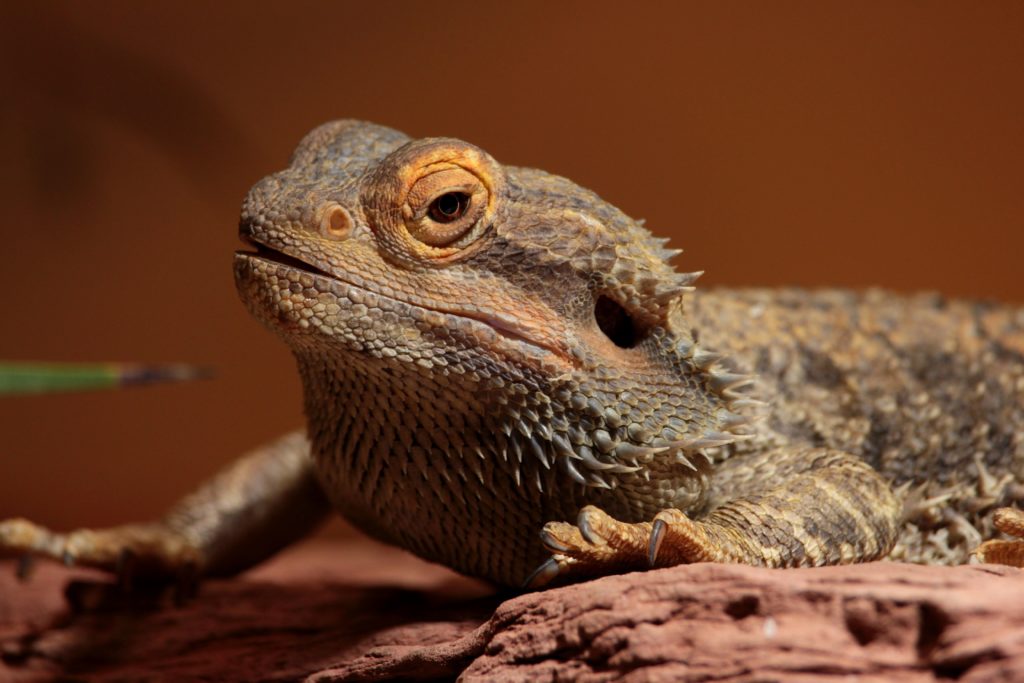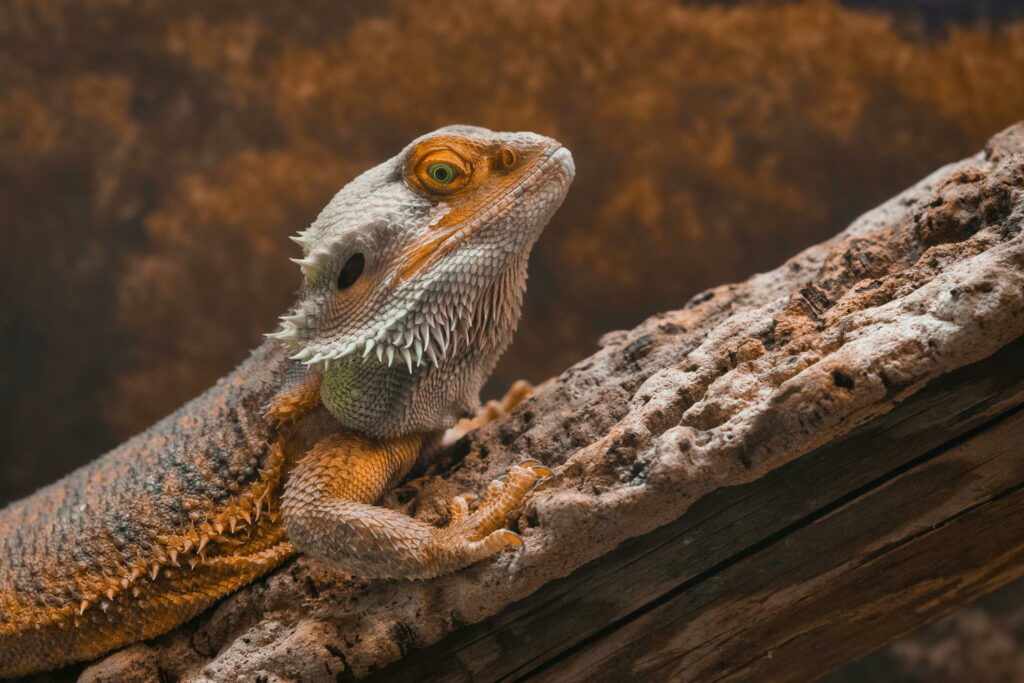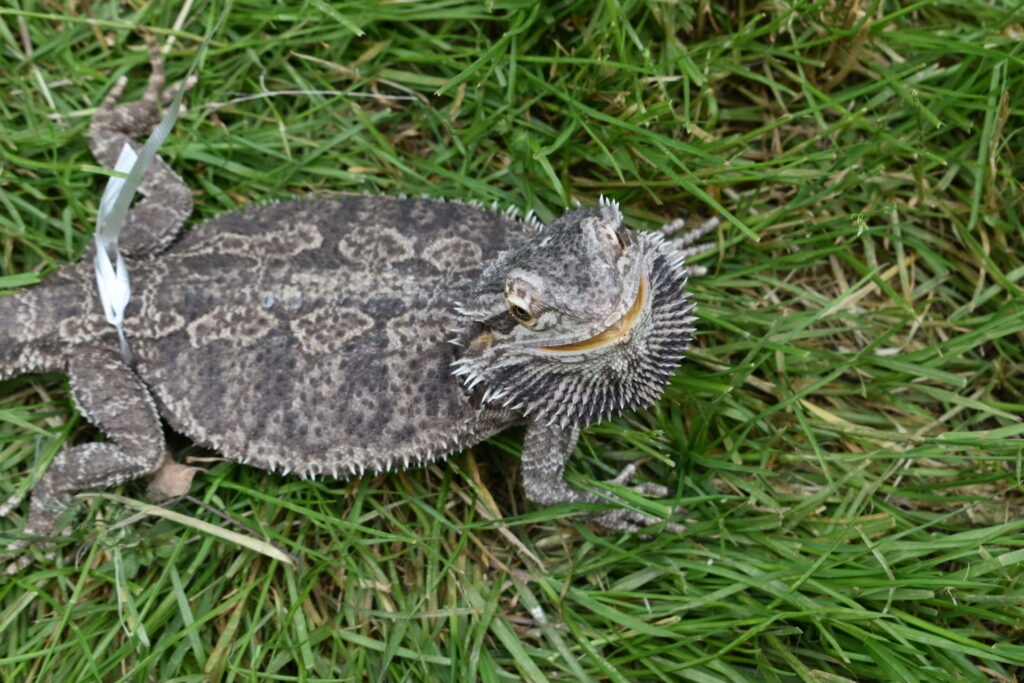Bearded Dragon
The most popular species kept in captivity is the Central Bearded Dragon due to its temperament and fecundity. (Keeping and Breeding Australian Lizards, Ed Mike Swan). The Black Soil Bearded Dragon is the most popular of the smaller species.
What should I feed my dragon?
Chopped fresh spinach, endive, Cos lettuce, peas, beans, zucchini, carrots, broccoli, asian greens and wild greens such as dandelions are all readily accepted.
Hatchling dragons will be eating mostly invertebrates. Young dragons may also be offered pelleted juvenile dragon food and a veggie mix. Insects should be dusted with an appropriate calcium powder supplement 2-3 times weekly.
Commercial pelleted food should NOT make up more than 50% of the diet. If you are certain your lizard is eating a significant amount of pellets, the addition of calcium and vitamin powders to the diet should be stopped or reduced.
Never feed a COLD reptile. Ensure your dragon is at its preferred optimum temperature zone (POTZ) when you offer it food. (A Guide to Health and Disease in Reptiles and Amphibians, Ed. Carmel and Johnson.)
How should I feed my lizard?
How OFTEN you feed your lizard and WHERE you feed your lizard is important.
Adults should be fed 2-3 times per week. Hatchlings should be fed daily and juveniles, depending on growth rates, should be fed every second day. When your dragon is about one year old it can be fed as an adult depending on general health and growth achieved.
Feed your lizard LIVE food in a separate plastic tub, with a lid. Do not feed live food in your lizard’s enclosure. This is to prevent your lizard swallowing substrate such as sand or bark from its tank with the live prey. You are also able to tell exactly how much live food your pet has eaten and it stops live prey BREEDING in your tank, yuck!
Your lizard will usually pass droppings after eating and so your tank will also be cleaner, decreasing the buildup of parasites, fungi and bacteria that could be harmful to your pet.
Vegetables and greens can be fed in your pet’s enclosure on flat ceramic or moulded plastic dishes. Anything not consumed in a few hours should be removed.
Do my lizards need supplements?
Dusting frequency should be 2-3 times weekly for dragons under 1 year of age and decreasing to once or twice weekly for mature dragons.
How do I house my dragons?
It is important to understand that hatchling lizards will require a much smaller enclosure than an adult. One size does NOT fit all, and enclosures often need to change as your lizard grows. Hatchlings do not do well in large terrariums and benefit from hides and a well-insulated enclosure in order to achieve higher temperatures required for growth.
What lighting do I need?
What heating do I need?
It is recommended that a HEAT GRADIENT of 28 to 39 degrees Celsius is provided in your lizard’s enclosure. The heat source should be at one end of the enclosure to allow the reptile to move away from it if necessary. This allows your pet to regulate its body temperature to maintain a healthy metabolism, digestion and immune function.
These temperatures are usually achieved by using a radiant heat lamp (ceramic or infrared) and a heat mat at the ‘cool’ end. A thermostat should be used to control the temperature at the ‘hot’ end. The enclosure should further be regularly monitored by a thermometer at each end to ensure a heat gradient is achieved.
Does my lizard need to go to the vet?
Do not put new lizards straight in with existing pet lizards until they have seen a veterinarian. Parasite tests should be performed and a minimum quarantine period of 30 days should be allowed before introductions occur. This gives you a chance to observe your new pet and allow him/her to recover from the stress of relocation.
Do I need to worm my lizard?
Can I train my lizard?
Should I have my pet lizard desexed?
You may observe reproductive behaviours in your pet lizards. Dragons may show a variety of territorial and mating behaviours such as head bobbing, arm waving, circling, tail whippings, beard inflation and colour change. These behaviours are a way a dragon communicates to another dragon and also responds to a perceived threat. Female dragons may lay eggs if they have been housed with or without a male. A period of decreased activity may be followed by increased activity with digging and oviposition (egg-laying).
It is not advised to house adult males and females together as aggression can result in serious bite wounds.
Hazards around the home
Rope or synthetic fibre ingestion is another common cause of disease in companion parrots. Sources of fibre include rope toys, towels, cage coverings or carpet. Do not use toys or perches made of synthetic fibres.
Bumblefoot is a term used to describe swelling, thickening ulceration of the skin on the soles of the feet. It is caused by the use of smooth wooden dowel or plastic perches. No tree branch is ever the same and thus wild birds do not suffer from this condition. To prevent this condition in your pet bird, use dried eucalypt branches or native foliage as cage perches instead of rope or dowel and replace these regularly. Natural branches have the added bonus of having a bark covering which can entertain parrots for hours as they rip and tear at it.
Smoke from fires, candles, incense or cooking is harmful to birds and exposure should be avoided. Smoke from Teflon frying pans may be toxic. Do not house your bird in the kitchen or let it free fly when you are cooking.
What if my lizard gets sick?
Cindy Jarratt BVSc(HonsI)MANZCVS (Avian Health)




